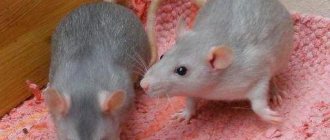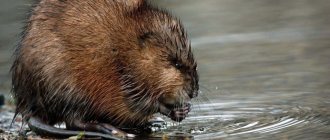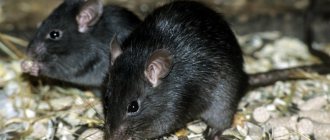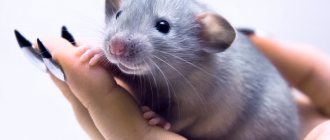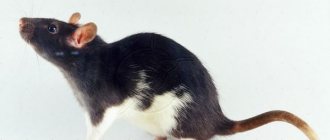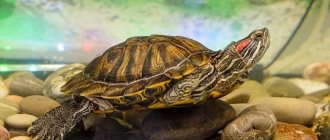- Wild animals
- >>
- Mammals
The water rat or water vole is a frequently encountered animal in our area. A small rodent that lives near water bodies. These are very cute and harmless animals in appearance, however, in agriculture, water rats are considered dangerous pests due to the fact that they cause damage to trees and crops. They are carriers of many dangerous diseases.
Origin of the species and description
Photo: Water rat
The water rat or water vole (Arvicola amphibius) is a small mammal that belongs to the order of rodents, the family of voles. The genus Water Voles includes only one species, Water Voles.
Rodents are very ancient and extremely common animals. Rodents inhabited our planet during the Cretaceous period. The oldest fossils of rodents date back to the Pleocene period, at which time the animals inhabited the territory of modern America. Over time, the appearance of animals has undergone changes, animals have successfully adapted to environmental changes, and at the moment there are 11 families of the rodent order in our country alone.
Video: Water rat
The vole family includes 15 genera. Most species of the vole family are small rodents with a small muzzle, small ears, short legs and a tail. The mouth has strong teeth with which they are able to gnaw through fairly hard wood. The fur of most rodents is short, while that of the water rat is long and thick. The Water Rat has a particularly long tail, which is slightly flattened on the sides, and there are no webbed toes on the hind feet. Water rats differ from other rats in having small, almost non-protruding ears, from gray voles in their large size, and from muskrats in the shape of their tail.
Palevaceae are one of the most numerous groups of rodents that can easily tolerate harsh environmental conditions and feed on low-nutrient foods such as greens, bark and roots of trees and shrubs, and grains. Water rats settle near bodies of water, but can also live in a field next to a body of water and in the forest. Animals of this species are active around the clock and live in burrows. They do not hibernate.
Appearance and features
Photo: What a water rat looks like
The water rat is a small mammal. The length of the animal is about 140-220 mm. Depending on the habitat and quality of life of the animal, body size and weight can vary greatly. On average, the body weight of a water rat is from 130 to 350 grams. The animal's body is massive and clumsy. On the feet, the third toe is longer than the others. There is no hair on the heels. The tail is long in size, equal to half the length of the body, round in cross-section. The ring scales on the tail are absent and there is sparse hair.
The tip of the tail ends in a tassel 0.5 cm long. The color of the animal can vary from red to black. In different seasons, the color of the animal practically does not change. The water rat's fur is soft and fluffy. The cover is differentiated into underfur and rough axis. The rat's belly has lighter fur than its sides and back. In appearance, the animal is similar to a rat, but differs in fluffy fur, tail shape and larger size. The eyes are small and black. The ears are small and practically do not protrude from the fur; also, due to the long fur, the animal’s paws are almost invisible. In the mouth, the incisors are brownish in color, the animal has 16 teeth. Females and males have no external differences.
The stride length is 7-8 centimeters, they are larger than those of ordinary voles. Water voles are very good and fast swimmers, can swim quite long distances, and are able to obtain food for themselves under water. On land they run quite quickly, especially if the animal is scared. They communicate with each other by squeaking. The lifespan of a water rat is 3-4 years.
Content
A muskrat farm must be set up on dry sandy or super-sandy soil; groundwater must be at a depth of at least 2 meters from the ground. Muskrats cannot do without clean water, and they do not tolerate drafts very well , so cages should be located on the downwind side of residential buildings. The height of the fence should be about a meter; it is advisable to cover the top of the fence with a 50 cm canopy so that animals cannot escape. The lower part of the fence is dug into the ground to a depth of 60 cm.
Musk rats can be kept in both open and closed areas. The simplest option is considered to be external cellular content. This means that the animal lives all year round in cages that are installed under a canopy . The height of the cages should be oriented towards the length of the largest individual, and the width should be such that you can reach all the corners of the cage with your hands. When turning in place, the animal should not touch the walls of the cage with its fur.
Important! It is imperative to ensure that the cage is impenetrable to rats, as they can eat the muskrat's offspring.
The dimensions of the walking cages should be 90x50x50, they can be made of wood or slate in the shape of a parallelepiped, a hanging house measuring 30x50x30 with a round hole with a diameter of 15 cm is attached on top. To prevent the muskrat from gnawing the circumference of the hole, it is covered with tin.
Fresh air is very important for the animal, so the roof and floor are made double - non-removable mesh and removable boards.
It is quite practical to keep muskrats under sheds - special sheds with a gable slate roof, under which cages are located in two lines with a passage in the middle.
It is advisable to equip animals with swimming pools , since physical activity helps improve the metabolism of animals. If the size of the farm does not allow you to build a swimming pool, you can provide the muskrats with basins of water, the water in which must be changed frequently to prevent the development of diseases.
Important! In winter, muskrats should bathe for no more than half an hour. In the summer, without bathing, the animal will simply overheat and die.
In addition to the reservoir, the animal needs a lot of drinking water, so in addition to feeders, the farm must also have drinking bowls.
What does a muskrat eat?
Proper feeding of a muskrat is the key to its health. Typically, animals are fed with cereal-legume or meadow hay, and in spring and summer, nettles, twig feed, and grass meal are prepared for them. In the summer, animals should be given succulent food - root vegetables, vegetables, fruits, vegetable tops, green legumes and cereals, and it is also necessary to include grain mixtures in the diet.
It is very important to feed animals only those fruits that are grown without the use of pesticides, since the muskrat is very sensitive to nitrates and may die. The muskrat needs to be given mixed feed, which is intended for rabbits and nutria, meal and cake.
As for food of animal origin, cottage cheese, fish and meat and bone meal are suitable for muskrats. In winter, succulent plants are replaced with Jerusalem artichoke, carrots, and pumpkin . During breeding, the muskrat needs to be given sprouted wheat grain. At the end of summer, animals should be given aspen and willow branches, as well as wooden blocks, so that they can grind down their incisors.
Do you change your pet's food depending on the season?
Where does the water rat live?
Photo: Water rat in Russia
The habitat of these animals is extremely wide; in our country, water rats can be found almost everywhere. Water rats inhabit the entire northern part of Eurasia from the Atlantic to Yakutia. To the south, the habitat of these animals extends from the Mediterranean Sea to Asia and northern China. Also, these animals are extremely common in the northern part of Mongolia, Ukraine, Belarus, the North Caucasus and Siberia (except the Arctic).
Water rats settle in river openings, near lakes, ponds and other bodies of water. For life it chooses places with a humid climate. In the North, settling in forest zones occurs on the banks of reservoirs, peat bogs, which are overgrown with pine and birch trees. In the steppe, it lives in swamps and on the shores of lakes around which sedge and reeds grow.
With the onset of cold weather, these animals move to forests, or to gardens and orchards, where these animals can more easily obtain food for themselves. Capable of migrating over long distances. A vole can overwinter under a haystack, or underground in a burrow. Water rats build burrows near water; during floods, they can build open nests in thickets of grass and reeds. In autumn it digs holes in meadows and fields. The length of the hole is about 3 meters; in winter the holes do not freeze, and the animals can easily survive the winter.
Now you know where the water rat is found. Let's find out what the water vole eats.
Description
The water rat is a rodent from the hamster family. This animal is the largest of the voles: weight 130-350 g, size – 120-250 mm. The tail is long, round in cross-section and makes up half the length of the body or even 2/3 of its length.
Externally, this rodent looks like a gray rat. The muzzle is shortened, the ears are small, the incisors are reddish-brown in color. The eyes are smaller than those of a rat. The coat is thick with abundant undercoat; color dark brown. The tail is covered with short hair, which gathers into a small brush at the tip.
the water rat looks like an ordinary gray rat
Habitat
- Asia Minor and Western Asia;
- Northwestern regions of China;
- Northern Eurasia (from the Atlantic coast to Yakutia);
- Northern Mediterranean coast;
- Territory of the Russian Federation (except for chernozem);
- Belarus;
- Western Ukraine;
Life expectancy is 2-3 years.
Origin
The water vole has existed over vast areas for hundreds of years and spreads through migration and transport (with cargo).
Lifestyle
This species prefers to settle along the shores of lakes, on river floodplains, near irrigation canals, and in wetlands. The aquatic individual also inhabits meadows, swampy small forests, and is found in fields, vegetable gardens, bush thickets, and sometimes in buildings.
In winter, the animal migrates from reservoirs to meadows and bushes. The water vole lives in nests that it builds on or above the ground. For the winter it moves into a hole. In autumn and winter it is found under haystacks, in barns and vegetable gardens. Sometimes rats live in colonies.
Water rats are good swimmers. That's why they like to settle near bodies of water
The rodent swims well. It is most active at dusk and at night, but can also be found during the day (in the warm season).
One animal is capable of making a hole 100 m long.
What does a water rat eat?
Photo: Water rat in the garden
The water rat is a herbivore and feeds exclusively on plant foods.
The diet of a water rat includes:
- reed;
- cane;
- sedge;
- arrowhead;
- horsetail;
- waterfowl and algae;
- water lily roots;
- rhizomes and tree bark;
- young shoots of bushes;
- vegetables fruits;
- moss;
- plant seeds, spikelets of grain crops.
In the summer, rats get their food near a pond, where they feel completely safe. Minks and rats dig out the entrance near a pond, so that when leaving the water you can immediately hide in the hole in case of danger. In autumn, these animals move to forests or closer to fields and cultivated plantings.
In winter, they feed mainly on the bark and rhizomes of fruit trees and shrubs, causing them irreparable harm. Therefore, farms are actively fighting these rodents. Water rats are not picky eaters, so they are able to survive even in the harsh conditions of Siberia and Yakutia.
Interesting fact: Water rats feed only in specially designated areas. They arrange “feeding tables” or “feeding holes” for themselves where the animal can eat in peace. Such places can be recognized by the presence of various scraps on them in the form of half-eaten leaves and stems.
In captivity, water rats are fed grain, grass, melons and various fruits and vegetables.
Feeding characteristics of the water vole
— Advertising —
The rodent's diet includes succulent shoots of plants, tree bark, earthworms and cultivated plants. Thus, a large colony of water voles can destroy the entire harvest of a garden, since the animals are very voracious. They also cause damage to trees by completely eating the bark near the base of the tree. They stock up on food for the winter.
Due to such widespread damage to agricultural crops, water voles are being combated. Poisons are rarely used in this case, due to the fact that they harm plants. In large meadows, ultrasonic repellers and traps are used. In private small gardens, cats are often used for control.
Features of character and lifestyle
Photo: Water rat vole
Water voles are very calm animals leading a rather secretive lifestyle. In the summer, they live near bodies of water and spend most of their time in the water. By autumn they move closer to human settlements or to forests. There, these animals dig holes and underground tunnels with a large number of entrances from different sides. Before entering the hole, rats gnaw the grass, creating a semblance of a lawn. In the fall, animals store food in their burrows for the winter. Rats store grain, roots and everything they can carry into the hole.
In winter they do not hibernate; they emerge from their burrows by breaking through the snow. In addition to winter supplies, they feed on the bark of fruit trees and shrubs, and plant seeds. Rats live in colonies, but live alone. During floods, animals move to higher ground and sometimes even climb trees. Rats are active around the clock. In the summer, they spend most of their time in the water, swimming in it and getting food. In the fall, it digs holes and creates reserves for the winter. In winter, it emerges from its burrow only to get food for itself.
Water rats are very smart and cunning animals; they have a lot of enemies, but they are able to escape from them very easily and quickly through numerous underground passages. The social structure is undeveloped, they live mostly alone, but the burrows of water rats are often located nearby. Water rats are not aggressive unless they are threatened. People are treated normally in conditions of captivity and recognize their owner. If the animal senses danger, it may bite.
Interesting fact: Water rats are carriers of dangerous diseases such as Omsk fever, tularimia and many other diseases. Therefore, if you see a rat in the wild, you should not pick it up, or pet the animal, it is better to avoid it.
Social structure and reproduction
Photo: Water rat in winter
Water voles reach sexual maturity at the age of 2 months. Water rats reproduce very quickly. The mating season falls during the warm season. Over the course of a year, the female manages to bear 2 to 4 litters. The female's first pregnancy of the year occurs in early spring, the last at the end of August. A special peak of reproduction in water rats occurs in July. During the cold season, water rats rarely breed, only if environmental conditions are favorable and food is available with which they can feed their offspring.
In one litter, 5-7 cubs are born. Pregnancy lasts 21 days. Rats are born blind and without fur, but they grow very quickly. The offspring are mainly cared for by the female; the cubs spend the first few weeks of life exclusively in the burrow. At first, the mother feeds the cubs with milk. Over time, little rat pups begin to eat plant food that their mother brings them, and later they begin to get their own food on their own. Already 1.5 -2 months after birth, the young female is ready to reproduce.
Massive outbreaks of numbers often occur among these animals. During such periods, animals populate fields en masse and can cause significant damage to agriculture. Scientists are unable to trace the causes of such massive outbreaks. The range of sharp outbreaks of increases in the number of rats is limited to small areas.
Natural enemies of the water rat
Photo: What a water rat looks like
The natural enemies of water rats are predators such as:
- foxes;
- caresses;
- minks;
- ferrets;
- otters;
- hawks;
- eagle owls and owls;
- kites and many other birds of prey;
- dogs and cats;
- snakes and lizards.
Almost all predators hunt water rats. However, water rats are quite cautious, intelligent and cunning animals. Sensing danger, a rat can hide from the enemy in a split second; the most important thing is to get to one of the entrances to the hole. On the water, a water rat can hide from persecution by hiding under water. These animals are excellent swimmers and they swim well underwater.
But the main enemy of water rats was and remains man. Water rats cause great damage to agriculture. They destroy cultivated plants and harm fruit trees. Water rats are not poisoned with poisons in the same way that they can poison crops, and rats are quite smart animals and test unfamiliar food. They first bite off a small piece and if they feel that there is something wrong with the food, they don’t touch it anymore.
Farmers install special ultrasonic repellers on their plots that prevent animals from reaching their crops. Water rats are exterminated in large numbers near farms in gardens and vegetable gardens. Animal fur is also highly valued, and many animals are killed for their skins. The skins are harvested in large quantities.
In addition, the number of animals is strongly influenced by the state of the environment. Scientists have noticed that in dry years, with hot summers, the number of water rats decreases sharply. This species is susceptible to diseases such as tularia, Omsk fever often suffers from helminth infections.
Methods for controlling water rats
All measures to eliminate water voles can be divided into two types:
- destruction;
- scaring away
The first type is more effective, since the more rats you exterminate, you will thereby protect yourself from a re-invasion of rodents. But the second type is more humane in relation to nature, but having scared off a vole once, it is not a fact that it will not return to you for potatoes.
Biological
These are perhaps the most effective methods. This includes the capture of animals by large pets, such as a cat or a dog. If the cat is not such a rat-catcher, then the presence of the cat’s smell in the garden is enough to scare away the uninvited guest.
Rat hole
They do this: they pour sawdust soaked with cat urine into the rat holes that appear and dig them in. Smelling the smell of excrement, the rat turns to run. Dogs are also capable of scaring away a small rodent; although they will not eat it, they can bite it to death. At night, hedgehogs and ferrets fight rats.
Mechanical
These methods have been tested for centuries. Mousetraps and traps have long been used to catch rats and mice. Here these devices can also be useful, but if the populations are small.
- Place a trap or mousetrap next to the hole;
- Wear gloves to prevent human odor from getting on the device;
- You can put a piece of potato or other bait;
- Having smelled the bait, the rat will not stay away and will definitely visit the metal trap.
Chemical
Chemical methods of influencing rats
Mention should be made here of rat poisons, which can be found in any veterinary store. Poison should be used as a last resort, in the event of a large rodent infestation. But since pets may live on the site, it must be used very carefully.
As a poison, you will need powders containing zinc, phosphorus or arsenic. To prepare bait with a poisoned agent, you can make the following design:
- Cut any vegetable in half;
- Remove the pulp from it;
- Stuff the insides with poison;
- Fasten the vegetable halves and place them near the hole.
You can pour the poison into small boxes, bury it in the ground at some distance from the hole, and put bait in it. Works great.
An alternative to store-bought poisons is simple bleach. Once on the mucous membranes of the rat, a reaction begins, after some time the animal will die.
Ultrasound
Ultrasonic rodent repellers
Everyone knows the modern method of repelling rodents - ultrasound. The more repellers placed on the site, the better. The emitted sound waves negatively affect the nervous system of voles. When installing the device, it is necessary to set the maximum radiation value so that the effect is enhanced.
As repellers, you can use combined devices that emit waves of sound and vibration, these are designed to fight moles, but are also suitable for such rodents.
Traditional methods
Since the rodent lives in the ground and moves like moles, the methods used in the fight against moles are also suitable for exterminating water rats.
Repellers from a bottle
- Stick metal rods or pieces of reinforcement into the ground. Put tin cans on them, which will create noise and rumble when the wind blows;
- Designs made from plastic bottles are suitable as a homemade repeller. They can be made in the form of windmills, you can simply put them on stakes and place them around the perimeter of the site. By creating rotational movements from the wind, vibration and noise will enter the soil and repel pests.
Of course, the listed actions with cans and half-pots will not bring the maximum effect, but you can still scare off a few individuals. It is better to use such structures in conjunction with ultrasound, poison and traps.
Conclusion
It is known that any rat will not start out of nowhere. If your site is adjacent to a small body of water, try to keep the shoreline clean and do not throw food waste nearby.
Then the rat will have nothing to react to, and it will go to another garden, where there is sewage, beds overgrown with grass. But if individuals appear, then you need to engage in a duel with them immediately.
